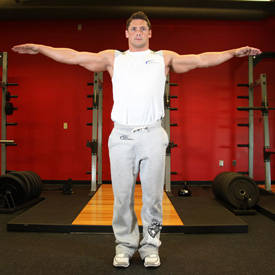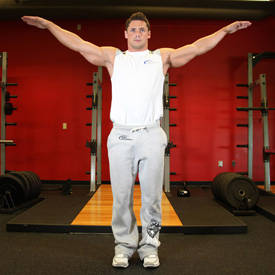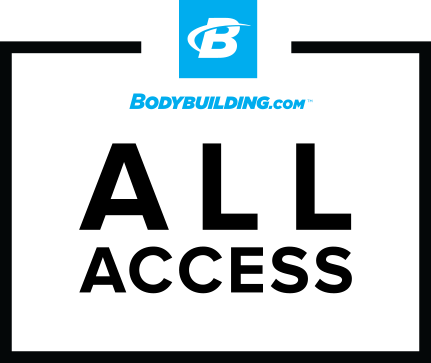As a trainer, I always get the same questions from people over and over. How many sets should I do? How many reps should I do? What kind of training split should I do?
I've realized over the years that most people just don't know some very basic stuff when it comes to constructing their exercise programs. People lack knowledge, but what is much worse than ignorance is that most people can't differentiate good information from misinformation. When your BS detector isn't functioning, then you're susceptible to a lot of bad training "advice" and marketing scams.
I'm going to review some common training myths and frequent questions that I get as a trainer. To achieve your physique potential, you'll need to let go of some common misconceptions. Where the mind goes, the body follows.
Warm-Ups
A lot of lifters can get revved up about their lifting, but not so much about warm-ups. I don't need to tell you that warm-ups are necessary to prevent injuries, but a lot of people don't know how to go about warming up. First, let's get this straight: warming up IS NOT stretching.
General warming up is when you get the blood flowing through light non-traumatic movements: arm circles, jumping jacks, light jog, light biking, etc. Stretching is stretching, and doesn't warm your muscles. In fact if you stretch while your muscles are cold, then you'll likely injure yourself.


Arm Circles
Stretching should be done after the workout. After a workout, your muscles are pumped up and tight, so that is when you need the stretching the most. If you need to stretch before a workout, then you would only do so after a thorough warm-up to loosen specific muscles that are chronically tight.
Here's a simple no-brainer warm-up to cover the whole body:
- 3 sets of "halos" at 8-12 rotations in both directions. A halo is when you hold a 25 pound plate and rotate it around your head with the hole at eye level.
- Stationary bike: light cycling for 5 minutes
The great thing about this warm-up is that you use short rotational motions with these exercises to get the blood flowing into your joints and muscles, but it's not anything exhaustive or traumatic.
Exercise Rotation


Dumbbell Bench Press
What marks an advanced bodybuilder from a beginner? One thing is whether their program is different from workout to workout. Ask a beginner what he did for his chest, and he'll say, "Bench press, incline press, dumbbell press, flyes."
Ask him what he'll do for his next chest workout, and he'll say, "Uh... bench press, incline press, dumbbell press, flyes."
Ask him what he'll do for his chest workout after that, and he'll say, "Bench press, incline press, dumbbell..."
DEAR GOD! Somebody put this guy out of his misery!
One of many ways to make your routine different from workout to workout is to rotate your exercises. So rather than do four exercises for each body part at every workout, just do one at each workout and change it up from workout to workout. This is a much better way of training, because each exercise comes off as fresh at each workout.
Repetitions
When some newbie asks, "What's the best rep range for mass?" the usual dogma states, "8-12 reps." Then the poor newbie does 8-12 reps on every exercise in the hopes of getting Mr. Olympia-big.
In my experience of training people, I've found the 8-12 rep range to be crappy for mass. People can get big on this rep range, but if they stay in this range all the time, they'll stagnate.
Your muscles have a wide variety of fiber types, each responding and growing to a different weight and rep range. So if you're interested in full hypertrophy, then use a wide variety of reps. It's like playing the piano: you're not playing a song if you're hitting the same note over and over.
Most people (again, newbies) imitate others in the gym and pyramid their weight to hit a wide variety of reps. The classic pyramid of 10/8/6/15 is used quite often and to great success because of its simplicity. The only problem with traditional pyramid training is that the rep range is too broad. Your nervous system gets confused, because you're waking up every muscle fiber, but you're not following up with repeated effort to make them grow.
Your body likes to narrowly focus on one rep range at a time. Instead of pyramid training, try periodization:
- Workout #1: 10-12 Reps
- Workout #2: 8-10 Reps
- Workout #3: 6-8 Reps
This is a far better way of training for both strength and hypertrophy.
Sets
How much volume (number of sets and reps) you can tolerate is contingent upon how much testosterone you have. There are many other hormones that contribute to muscularity and size. But in general people with a high amount of testosterone (i.e. porn stars, violent felons) can tolerate and grow on a high number of sets.
Eunuchs and those who watch "The View" every morning can only tolerate 1-3 sets per body part. I find that 10-13 sets per body part borders on overtraining for most people. 3-5 sets per exercise (totaling at 6-8 sets per body part) is what the average lifter responds to without overtraining.
Tempo
Here's one topic in bodybuilding that gets overlooked: tempo. How quickly or slowly are you supposed to lift the weight? To answer this question or any question, I always come back to this: what's your goal? What's your goal in lifting in the first place? Are you lifting to look good, or to perform athletically?
Related Video Workout Tempo is Important
Watch The Video -12:20
The other thing I always assess is "How are your muscles wired?" Are you geared for slow strength and neural endurance? Or are you designed for speed and explosiveness?
Of course, it's much more complicated than this. Although people can be categorized as either fast or slow, each muscle group has it's own individual characteristics, each with it's own peculiar way of training. Some muscles respond to explosive lifting, some respond to constant tension.
To further complicate things, different exercises require different tempos. Olympic lifts obviously require explosive movement while many bodybuilding exercises (not all) require constant tension.
To make things simple for you, just go with the goal you have in mind. In other words, your goal dictates your method, genetics be d@mned. If you want to look good for the beach, then steady constant tension in your lifting is the best thing for you. If you want to perform athletically, then speed is king.
I will say this though: I have found speed and explosiveness to be largely a genetic thing. You can teach somebody to slow down a lift, BUT teaching someone to be fast is difficult. Either you're fast or you're not. Most people are not. But if you discover that you're built for speed (a martial arts striker, Olympic weightlifter or track athlete), then maximize that advantage and train accordingly.
Frequency
I got a question recently about high frequency training (HFT) and whether it was effective for size and strength. My answer?
H#ll yeah, it's great for size and strength! The definition of high frequency training is when you train a body part 3 or more times per week. Most people will say that's overtraining, but that is fear talking. Strength is a skill that needs to be practiced. And like any skill, the more you practice perfectly (i.e. workout), then the greater your strength gains.
With hypertrophy, however, your size gains on a HFT program are dependent on your high frequency eating. Would you gain more muscle in the long run on HFT program as opposed to a low frequency program, say Max-OT? NO.
Would you gain muscle at a faster rate? OF COURSE!
One of the keys to making HFT work is active recovery. Active recovery sets are light sets of 12 reps and beyond (15, 20) to pump blood through your muscles to flush out the lingering waste by-products (indicated by muscle soreness) from the last workout and transport in nutrients and circulating hormones to facilitate recovery and growth.
People from different bodybuilding and powerlifting camps have called these sets by various names, such as feeder sets, flushing sets, pump sets, etc.
In a HFT program, one of the workouts should be an active recovery workout. Do 3 light sets of 13-15 reps for each body part, and you've facilitated recovery from the last workout and prepped yourself for the next.
Unlearn What You Have Learned
Misinformation and training myths have a life of their own and can breed in the minds of young lifters. If you want to train smart, then you've got to unlearn what you have learned and do your homework in and out of the gym.

